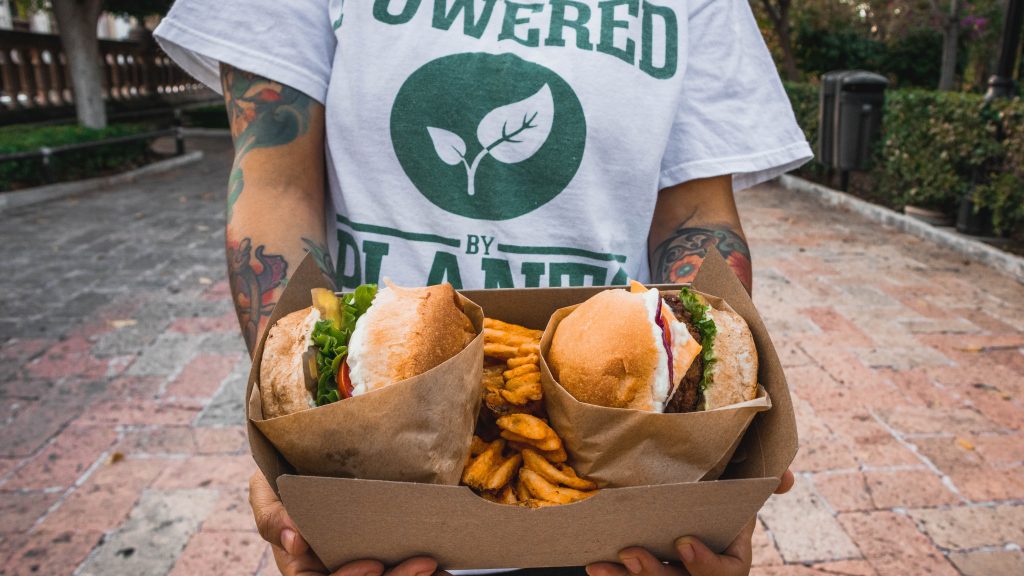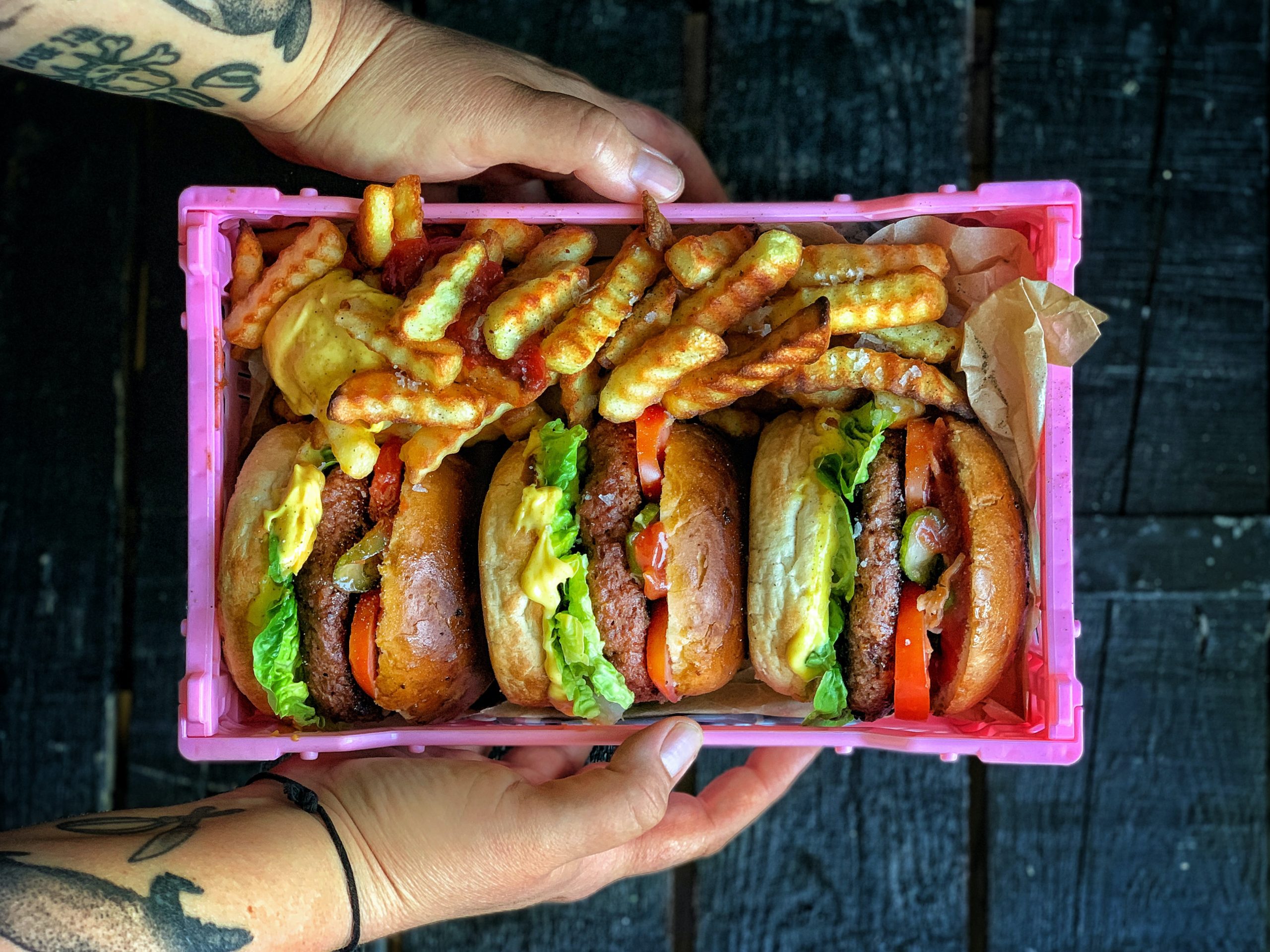Top insights to implement into your plant-based menu strategy and save the planet, to boot!
In Part I, we discussed the importance of normalizing plant-based food options in fast-food venues. We also learned that clever menu strategies are the way to make plant-based options appeal to ‘mainstream’ consumers.
So, let’s move on to the how.
Whether you need to add plant-based options to your fast-food outlet for the first time, or the sales of your current options require elevation, we’re here to help you jump-start your plant-based menu strategy.
Last week, ProVeg International published its inaugural International Fast Food Ranking Report. The project assessed the landscape of plant-based offerings at the five biggest fast-food chains worldwide, using ProVeg’s scorecard methodology to rank the top restaurants.
The report showcases the contributions the top-five fast-food companies are making to the plant-based food space and highlights opportunities to capitalize on growing consumer trends in plant-based eating.
This article will summarize the main learnings from the Fast Food Ranking Report and enable you to implement the most significant insights into your business strategy.
Key players involved in the report
- Burger King
- Subway
- McDonald’s
- Pizza Hut (Dominoes, in the Netherlands)
- KFC
The International Fast Food Ranking Report found that the biggest players in the fast-food industry are adapting to the changes in eating habits taking place globally, but that there is room for improvement.
Countries analyzed
- The UK
- Spain
- South Africa
- Poland
- Germany
- Belgium
- Czechia
- The Netherlands
So, are you ready to boost your plant-based food service sales and drive your business’s sustainability credentials? Let’s get started.

1. Integrate plant-based options with animal-based menu items
Menu presentation is a key factor for consumer success in fast food chains, and a vital aspect of menu presentation is where you position plant-based products. But what’s the solution – displaying plant-based dishes separately to animal-based menu options, integrated with animal-based offerings, or both?
The International Fast Food Ranking gave the highest points to fast-food restaurants that integrated fully plant-based items in their overall menu and listed them first. This method helps to ‘normalise’ plant-based options among omnivore and flexitarian consumers by making them appear as if for everyone, not only for those who abstain from consuming meat and/or dairy.
For more information on menu integration, read ProVeg’s report on how menu design influences meat-eating consumers to choose plant-based foods.
In addition to item integration, it’s recommended that fast-food chains repeat plant-based menu items in a separate section of the menu. Utilizing both of these tactics helps to nudge mainstream consumers toward choosing plant-based while also making it easy for consumers who adhere to fully-plant-based diets to navigate the menu.
Restaurants that do this well:
- Subway – Menus across all countries consistently integrate their plant-based items with their animal-based counterparts.
- Pizza Hut – The majority of Pizza Hut menus across countries reviewed integrate their plant-based options into the general menu. Others, however, like Czechia, Germany, and the US list their plant-based options exclusively in a separate section of the menu, making them less visible to mainstream customers.
2. Rename additional veggie and vegan-specific menu sections with titles that possess a broader consumer appeal
To expand on consumer psychology and menu presentation – naming is vital. When it comes to those additional veggie and vegan-specific menu sections, it’s still important to ensure that you don’t allocate titles that alienate certain consumers. We’re trying to normalize plant-based food, here!
Give the sections titles that possess a broader consumer appeal and continue to make plant-based menu items appear as options that could be for anyone, not just veggies. We recommend names like ‘Plant-Based’ – or you can get creative.
Unfortunately, many fast-food restaurants use unappealing names for their separate plant-based menu sections, and so scored low on this front – most McDonald’s assessed by ProVeg use titles like ‘Vegetarian’, the majority of Burger Kings use ‘Veggie’ in their section title, while most KFCs and Pizza Huts feature ‘Vegan’ sections.
By simply renaming additional menu sections, the above fast-food chains could make plant-based menu items more attractive to non-vegan consumers and quickly boost sales.

3. Use ‘appealing’ and positive language to name and describe plant-based menu items
Which meal would you choose – a ‘meatless burger’ or a ‘juicy Texas BBQ patty’? Most consumers would opt for the latter! By using enticing and positive language to name and describe plant-based menu items,1 you appeal to consumers’ sensory cravings and hunger pangs… and thus, attract their wallets.
Tempt diners to plant-based options via the senses – use sensory and experiential words that describe your menu item’s taste, texture, and/or smell, like ‘juicy’, ‘tender’, or ‘creamy’. Using positive descriptors should also help frame plant-based items as equitable options to their animal-based counterparts on the menu.
Additionally, when naming menu items, choose words that focus on the product’s culinary theme, cooking technique, or brand of plant-based analog. Minimize the use of words like ‘veggie’ or ‘plant-based,’ and totally avoid words like ‘vegan,’ ‘vegetarian,’ or ‘meatless. Inasmuch, stay away from uninventive and unappealing dish names. Be creative and let your senses lead the way!
Restaurants that do this well:
- Subway, global – Most Subways serve products with names like ‘Rockin’ Moroccan’ and ‘TLC Teriyaki’. These names are optimal because they focus on the culinary theme of the dish while avoiding words that tend to turn away ‘mainstream’ consumers.
- Burger King, Spain – The chain’s menu description of its ‘Nuggets Vegetales’ reads: “The Nuggets of a lifetime, with the flavor you love so much”. The description roots the nuggets in a familiar, tasty consumer experience, though the item name could be improved to appeal to a wider audience.
- McDonald’s, UK – The restaurant’s plant-based burger is described as a “juicy plant-based patty co-developed with Beyond Meat,” which invokes a sensory experience and links to the brand analog. However, the item’s name, the ‘McPlant’, could be refined to attract more consumers.
4. Feature consistent, easily identifiable pictograms or letters denoting plant-based menu items
When you spot a plant-based food option on a menu, how often have you only known that item is free from meat, egg, and dairy products because the dish name includes the word ‘vegan’? (Think, Vegan Breakfast Bap or Big Vegan Burger.) Not only is it not very inventive, nor is it attractive to non-vegan consumers, but it’s not a reliable labeling system.
Consequently, don’t use the product name to function as the label. Use proper, consistent labels that are subtle yet easily identifiable to those looking for them.
Pictograms are great examples. They can help minimize the deterring effect that vegan-identifying denominations can have on meat-eating consumers while accommodating those who follow vegetarian or vegan diets.
Examples of suitable pictograms or letters to denote plant-based menu items:
- VE or V
- A small leaf symbol
* Make sure to display a key on your menu to explain what any used pictograms mean.
Restaurants that do this well:
- Dominoes, The Netherlands – For plant-based menu items Dominoes use a small ‘leaf’ symbol. These labels are identifiable to consumers adhering to vegan and vegetarian diets, yet subtle.

5. Prioritize promotion of your plant-based menu options in-store, on your website, and throughout social media
How can we make a ‘niche’ product appear popular and boost sales in the process? Create as much noise about it as possible!
Prioritize the promotion of your plant-based menu options over your animal-based items to push the former to the forefront of consumers’ minds. By doing this, you make plant-based dishes appear as the ‘norm’, reducing consumer reservations and increasing willingness to purchase.
This can be done through multiple channels, in dining-in or takeaway settings, on your website, and throughout your social media platforms. Dedicate events and social media posts to plant-based dishes, leverage your home webpage space to nudge consumers towards your plant-based menu items (position plant-based options above animal-based items), and spend less time shouting about your animal-based options in general.
Restaurants that do this well:
- Burger King, Germany: The restaurant prompts customers at the point of order and asks whether they want to enjoy the patty ‘plant-based’ or ‘with meat’. Though not accounted for in the Fast Food Ranking, these kinds of prompts at check-out are a strong move toward normalizing plant-based eating in an industry that has been built and centered on animal-based ingredients.
- Burger King, UK: In the UK, Burger King has several social-media posts across multiple platforms dedicated to promoting its vegan items, and currently promotes burgers with plant-based bacon at the top of the home webpage.
“More and more Germans reduce their meat consumption for various reasons. At Burger King Germany, we are keen to offer them a tasty and diverse range of Plant-based burgers, snacks and sides. Our claim: 0% meat. 100% taste. As a Plant-based pioneer in QSR, we extend our Plant-based portfolio continuously. We are happy if more and more brands join us in the plant-based journey.”
Key insights
Following the results of the International Fast Food Ranking Report, ProVeg International makes the following recommendations for food service businesses:
- Integrate plant-based options with animal-based menu items.
- Rename additional veggie and vegan-specific menu sections with titles that possess a broader consumer appeal.
- Use ‘appealing’ and positive language to name and describe plant-based menu items.
- Feature consistent, easily identifiable pictograms or letters denoting plant-based menu items.
- Prioritize promotion of your plant-based menu options in-store, on your website, and throughout social media.
So, what are you waiting for? Implement our top five recommendations to normalize plant-based food, drive your fast-food sales, and help the environment.
Extra recommendation:
Make sure to increase the ratio of tasty plant-based options on your menus in relation to animal-based meat dishes – so much about what feels ‘normal’ to consumers is related to what is available. If 50% of the menu (or more) is plant-based, that will feel a lot more normal than if only 5% of your menu is plant-based (even if you apply our nudges)!

You can learn more about why we need to normalize plant-based food in fast-food restaurants by reading this article. But make sure to uncover the full results of the International Fast Food Ranking Report, here!



